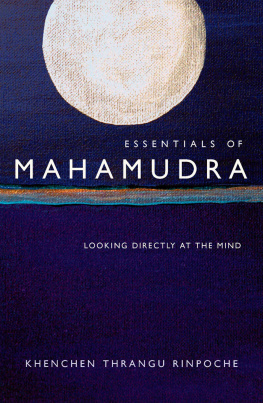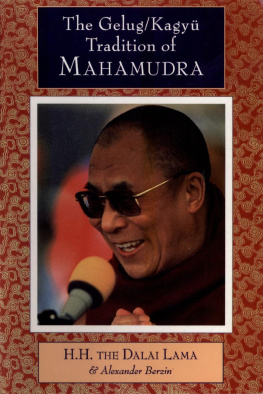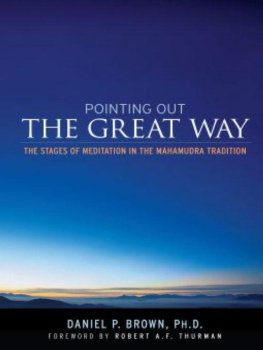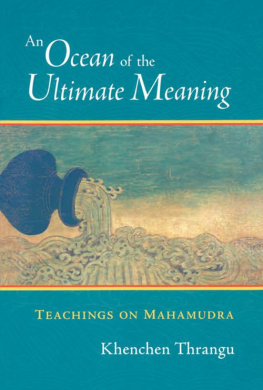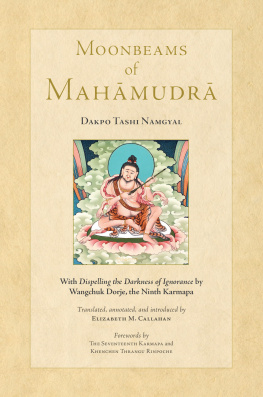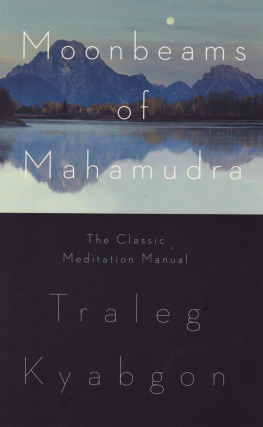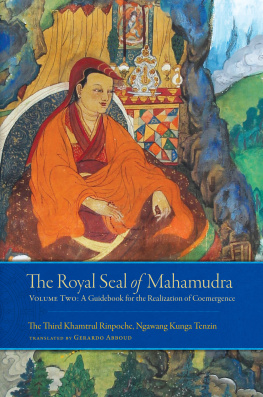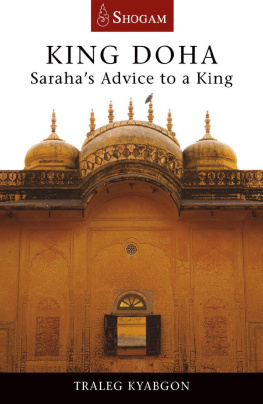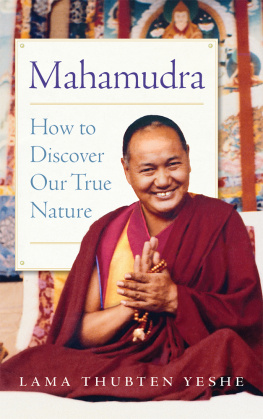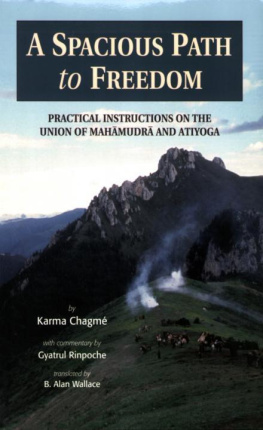

CONTENTS
Twenty-five hundred years ago, the Buddha taught that one can attain true, lasting happiness by examining and working with ones own mind. This message is as valuable today as it was then, for though we are now engulfed by material wealth, we are no more happy or secure. The root of this dilemma is the mind that keeps looking outside and grasping at external pleasures in order to achieve some measure of happiness. This method is futile, for a sure basis for stability can only be established within. Looking within is done through meditation.
There are two main types of meditation: tranquility (Skt. shamata) and insight (Skt. vipashyana). These two approachescalming the mind and developing wisdomform the basis for all other forms of meditation, including the mahamudra meditation taught in this book. Mahamudra is the examination of the nature of mind itself, what is called looking directly at the mind. Deceptively simple, it is actually an extremely advanced form of meditation that requires years of practice to develop. Nonetheless, due to its universal applicability and directness, it is a particularly valuable technique for people in our modern times who want to pursue Buddhist practice while making a living or raising a family.
Mahamudra has been practiced in Tibet since the twelfth century, particularly within the Kagyu lineage of Tibetan Buddhism. Most mahamudra manuals are simply instructions on what to do, with little or no explanation about the rationale behind the practices. Since the method of just following instructions without asking why is not compatible with the Western approach to learning, a more contextual presentation is valuable for us here in the West. Fortunately Tashi Namgyal (Bkra shis rnam rgyal, 151287), a great scholar and meditator of the sixteenth century, wrote a detailed explanation of both the fundamental reasons behind mahamudra meditation and its practice entitled Moonlight of Mahamudra (Nes don phyag rgya chen poi sgom rim gsal bar byed pai legs bshad zla bai od zer). Essentials of Mahamudra is a commentary on Tashi Namgyals text.
Between 1990 and 1995, Thrangu Rinpoche taught on mahamudra in five retreats held at Big Bear Lake in California. This book is based on teachings from the second through fifth of those retreats.
Thrangu Rinpoche holds the highest degree within Tibetan Buddhist studies and was requested by the Sixteenth Karmapa, the head of the Karma Kagyu lineage, to set up the curriculum for the lamas of the Karma Kagyu lineage. Thrangu Rinpoche is not only an eminent scholar of Buddhism, he is also recognized as having the realization of the practice of mahamudra. Thus he is well qualified to teach on this topic. In addition, Thrangu Rinpoche has taught thousands of Westerners in over thirty countries in the past two decades, and is very skillful in conveying the Buddhas message to Western ears.
Technical Notes
The chapter breaks generally follow the outline of Tashi Namgyals text, but doing so consistently would have proved very awkward. In addition, Thrangu Rinpoche occasionally addresses topics that are not mentioned in the root text, and for this reason some of the subheadings within the chapters are not contained in Tashi Namgyals outline.
Since these teachings are an amalgamation of more than one course, there was a certain amount of repetition in the transcripts. This has been minimized through editing, and what remains is there in order to retain the progression of Rinpoches presentation based on the root text.
Tibetan and Sanskrit words are rendered phonetically within the body of the book. For those interested, Tibetan transliteration is provided in a glossary at the back.
The numbers that appear in brackets throughout the book refer to the page of the English translation of Tashi Namgyals text, translated by Lobsang P. Lhalungpa as Mahamudra: The Quintessence of Mind and Meditation. Originally published by Shambhala Publications in 1986, it can be found also in a 2001 Indian reprint available from Motilal Banarsidass.
Acknowledgments
Id like to express my thanks to the many people who helped make this book possible. Over the years the following people have worked on correcting and editing this commentary: Peter Barth, Susan Chapman, Sandy Garison, Bill Lawless, Terry Lucas, Donna McLaughlin, Arline Mathieu, Laurie Milner, and Lama Tashi Namgyal. Needless to say, any errors that remain in this text are my own.
It has been my great privilege to work with Thrangu Rinpoches teachings for many years, and in particular to assist in making his mahamudra teachings available to the world. May the instructions here be of benefit to all beings.
Clark Johnson
Mahamudra Practice
There are many great Buddhist traditions, and of these the teachings of mahamudra are particularly helpful in these modern times. The reason I think that the mahamudra teachings are especially relevant and beneficial today is that we find ourselves in situations that are quite similar to those in which the great practitioners of mahamudra found themselves many centuries ago. The eighty-four great adepts, or mahasiddhas, who lived in India in the second to twelfth centuries found it necessary do spiritual practice in conjunction with their worldly activities. For instance King Indrabhuti ruled a large kingdom and was surrounded by great luxury. Yet he received mahamudra instructions, practiced them while ruling his kingdom, and achieved the supreme accomplishment of mahamudraenlightenment in one lifetime. Similarly the great scholar Nagarjuna, who composed many treatises on the meaning of emptiness, achieved the supreme accomplishment of mahamudra while carrying out vast responsibilities and difficult work. Other mahasiddhas were cobblers, arrow makers, sweepers, and even practitioners of such humble occupations as grinding sesame seeds. All of them combined their practice of mahamudra with whatever activities they were engaged in. There was, for them, no contradiction between the work that they had to do and the practice of mahamudra; no conflicts came up between Dharma practice and worldly activities. Thus the tradition of mahamudra arose and flourished.
Here in the West people are engaged in a great variety of occupations and thus experience a great diversity of thoughts. The practice of mahamudra allows each person to live as they wish, do the work that they want to do, and at the same time, without any contradiction, practice Dharma.
One of the best things about mahamudra practice is that it is peaceful and gentle, and there isnt a great danger of making terrible mistakes or creating a practice situation that can harm us. In contrast some other special practices can yield profound results if practiced well but involve the danger of unwanted complications. One such practice is known as the dark retreat, which entails doing contemplative practice while staying in a dark room for a month or so. If it is done properly it yields profound realization, but if it doesnt go well there is the danger of creating even greater difficulties for the person. Another example is the practice of going without food for seven or fourteen days. If done correctly it brings about the realization known as extracting the essence, but if done incorrectly it causes one to become sick and extremely unhappy.
Next page
